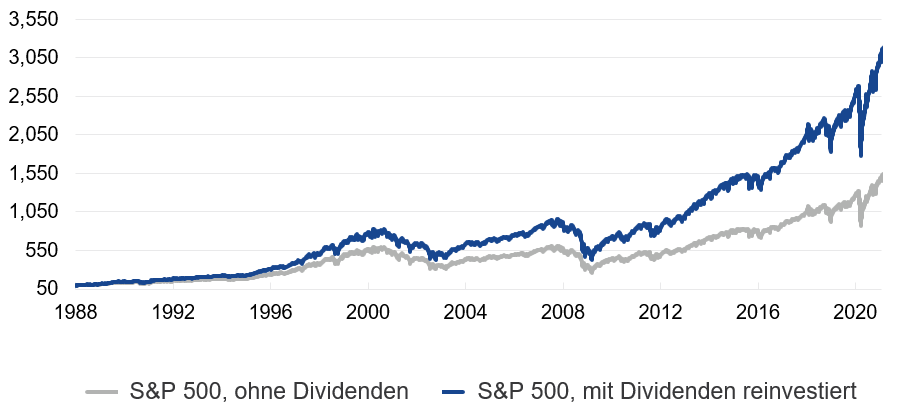ETF-Akademie Was ist eine Dividende?
Video: Dividende
Dominik Schmaus
Die meisten börsennotierten Unternehmen belohnen die Anleger, indem sie einen Teil der Gewinne in Form von Dividenden ausschütten. Diese kann im Laufe der Zeit zum wichtigsten Bestandteil der Aktienperformance werden.
Definition
Die Dividende ist der Teil des Gewinns eines Unternehmens, der an die Anteilseigner ausgeschüttet wird. Die meisten Aktien zahlen nur einen Teil ihrer Gewinne in Form von Ausschüttungen. Die einbehaltenen Gewinne werden für Investitionen in künftiges Wachstum verwendet.
Bedeutung
Im Laufe der Zeit trägt die Ausschüttung am meisten zur Anlageperformance bei – sofern sie reinvestiert wird. Warum? Denn wenn jede Ausschüttung reinvestiert wird, führt dies zu einer besseren Wertentwicklung. Dies wird als „Zinseszins“ bezeichnet. Die nachstehende Grafik zeigt, wie groß die Auswirkungen der Reinvestition von Ausschüttungen auf den S&P 500 Index des US-Aktienmarktes hätte gewesen sein können. Dabei wird die Rendite mit und ohne Wiederanlage von Ausschüttungen verglichen.
Der Effekt des Zinseszinses

Quelle: VanEck, Bloomberg. Stand der Daten 04. 01.1988 bis 30.06.2021.
Eine Einkommensquelle?
Viele Anleger nutzen Ausschüttungen als zusätzliche Einkommensquelle. Häufig nutzen Rentner diese für ihr Jahreseinkommen, während das investierte Kapital beibehalten wird.
Dividendenstarke Aktien
Diese zahlen höhere Ausschüttungen als der Durchschnitt. Dies kann darauf zurückzuführen sein, dass ein Unternehmen geringere Wachstumsaussichten als seine Konkurrenten hat und daher bereit ist, einen größeren Anteil seiner Gewinne an die Anteilseigner auszuschütten. Oder aber der Aktienkurs des Unternehmens ist gesunken, sodass die Ausschüttung im Vergleich zum Wert der Aktie eine höhere Rendite bedeutet. Seien Sie vorsichtig – ein Kursrückgang könnte bedeuten, dass der Markt einen Rückgang zukünftiger Ausschüttungen erwartet.
Ausschüttende ETFs
Ausschüttende ETFs sind eine sinnvolle Anlage für Sparer, die Erträge erwirtschaften möchten. Die höhere Rendite kann jedoch auch mit höheren Risiken verbunden sein, da bei einigen dividendenstarken Aktien, z. B. von Öl- und Tabakunternehmen, große Zweifel an ihrem künftigen Wachstum bestehen. Die Diversifizierung eines ETFs kann dazu beitragen, dieses Risiko zu streuen.
VanEck bietet einen ETF zum Thema Dividenden an.
Besteuerung von Ausschüttungen
Es ist wichtig, bei Anlagen die Steuern auf Ausschüttungen zu berücksichtigen. Einige Länder besteuern diese von den Anlegern erhaltenen Ausschüttungen. Anlagen in ETFs können den Aufwand für die Anleger verringern.
Quellensteuer
Viele Länder erheben auf die von einem Unternehmen ausgeschütteten Dividenden eine sogenannte Quellensteuer. Dabei handelt es sich um eine Steuer, die der breiten Öffentlichkeit weitgehend unbekannt ist. In einigen Ländern kann die Quellensteuer 15% betragen, in anderen Ländern sind es mehr als 30%. Aufgrund von Doppelbesteuerungsabkommen können Sie sich möglicherweise einen Teil dieser Quellensteuern auf Dividenden zurückholen. Wenn Sie betroffen sind, sollten Sie Ihren Steuerberater um Rat fragen.
Thesaurierende ETFs
Thesaurierende ETFs nehmen keine Ausschüttungen vor; sie reinvestieren diese automatisch. Diese fließen also in den „Zinseszins“ ein. Diese ETFs eignen sich eher für Anleger, die über einen langen Zeitraum Kapital aufbauen wollen, als für Anleger, die Ausschüttungen anstreben.
Ausschüttende ETFs
Ausschüttende ETFs zahlen alle erhaltenen Dividenden aus. Sie eignen sich vor allem für Anleger, die für regelmäßige Erträge investieren. Erfahren Sie mehr über den ETF von VanEck und die möglichen Vorteile einer Investition in dividendenstarke Aktien.
VanEck Dividenden ETF